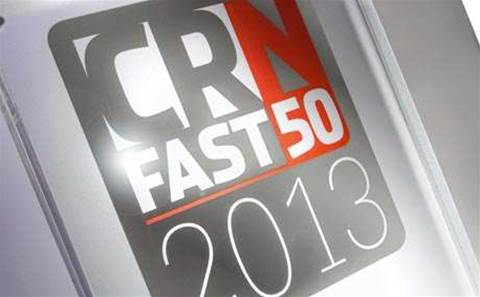Diversity
CRN tracks 21 revenue categories in the Fast50 (see main table, page 36) from the smallest – data centres – the largest – hardware. Typically, Fast50 companies were active across four to seven product categories, which was similar to last year’s result. The most diversified was Advent One, which operated across 10 different technology categories, making it the only company to hit double digits. Last year, four companies matched its diversity.
Advent One’s approach was reflected in its project scorecard. In 2012-13, projects for existing clients included storage and services for Monash University, software for CSL, IBM Pure Systems and services for Healthscope, software for Muirs, storage and services for Reece and power for Westfield. On the new business front, projects include power and services for Office Works, IBM Pure Systems and services for Clarendon and storage and services for Metcash.
In contrast, the most concentrated company in terms of revenue source was third-placed Outware Mobile, which makes all of its money from software development.
Number one on the list, NGage, identified eight separate technology categories where it is active. That’s a lot of balls to keep in the air at one time and its achievement is even more remarkable when you consider that the company only has four staff. However, as director Jarrod Bloomfield told CRN, it was a firm focus on hardware that helped the company grow so quickly.
Vendors and distributors
Respondents were asked to score vendors and disties on a five-point scale from ‘Most Important’ to fifth most important. By adding up these votes, giving five points for Most Important down to one point for the lowest category, it gives an interesting insight into the interplay between the major suppliers. (Click here for the full list).
Microsoft is now more important than ever to the Australian channel, at least as far as the Fast50 is concerned. In fact, the measure υ of its importance has increased in the last 12 months (see Top vendors, below).
HP remains the channel’s second most important vendor but the big surprise this year was Dell. The famously direct business has clearly become highly channel focused, and this year overtaken a clutch of companies to move into third in terms of importance to the Fast50. IBM and VMware, meanwhile, slipped, while Telstra dropped out of the top 10 all together.
Ingram Micro was clearly the most important distributor to the Fast50. Second place went to Express Data, while Dicker Data, Synnex and Avnet filled out the top five. Ingram received both the highest raw score plus the highest weighted score.
Activity breakdown
As this is the fifth year of the Fast50, it was instructive to look back to see how the technology preferences in the channel have changed.
The biggest contributors to revenue for the Fast50 of 2009 were end-to-end solutions, which typically provided resellers with 40 percent of their revenues, followed by consulting, networks, managed services and security.
Contrast that with the class of 2013. There is a big change due to methodology – which now recognises a standalone hardware category. And of course cloud has emerged as a major moneymaker. But some things haven’t changed in all that time. General business consulting, end-to-end IT solutions and managed services still rank among the top five activities for Fast50 companies.
And a final exclamation point. When we look at the 10 youngest companies in the 2013 Fast50, the majority are involved in either some form of cloud computing or infrastructure (servers and storage) provision. But none of the Fast50 companies founded since 2009 are involved in managed services.








_(11).jpg&h=142&w=230&c=1&s=1)


.jpg&w=100&c=1&s=0)
_(8).jpg&w=100&c=1&s=0)







.jpg&q=95&h=298&w=480&c=1&s=1)


.jpg&q=95&h=298&w=480&c=1&s=1)


